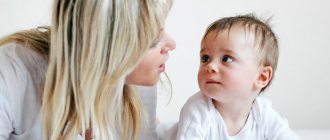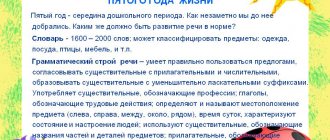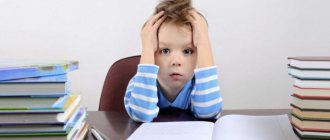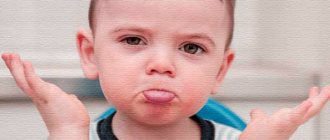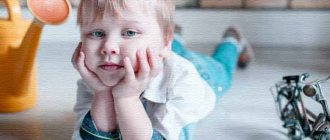What should a child's speech sound like at 5 years old?
A child at this age can:
By the age of five, the vocabulary increases to 3000 words. All sounds in the words of the native language are pronounced clearly, but the most complex “r”, “l”, as well as hissing sounds may remain, the pronunciation of which is normalized closer to six years.
The volume of the voice is already controlled, the desired intonation is reproduced, and the tempo of speech is adjusted. There are fewer omissions and rearrangements in words, but the stress is not always placed correctly, and mistakes are made when declension of nouns by case.
Five-year-olds memorize poetry well and can compose a detailed story based on a picture. They use all parts of speech and select synonyms. Their speech is already similar to the speech of an adult.
Why do children speak poorly?
There may be several reasons. Conventionally, they can be divided into organic and social.
Organic
Among these, lesions of the brain and hearing organs predominate. Less commonly, developmental disorders of the speech apparatus.
- Encephalopathy
A characteristic pathological process for children under 3-5 years of age. Accompanied by general disorders of higher nervous activity. Intelligence and memory decrease. In addition to speech dysfunction, behavioral problems or hyperactivity and attention deficit disorder (ADHD) are observed. Or lethargy, drowsiness, weakness. Both options are dangerous. Without special treatment, it is impossible to achieve functional restoration. They will continue to fade, development will slow down significantly. It is necessary to contact a neurologist.
- Birth injuries
Head injuries (TBI) and other options. Also asphyxia, for example, when the neck is compressed by the umbilical cord. Variations are possible. Birth injuries cause persistent disturbances in the functioning of cerebral structures. At best, only speech will be impaired. More severe problems, including secondary dementia, are also possible. Although there will be no organic underdevelopment in the clinic.
- Prematurity
Babies born prematurely are at greater risk. Because the brain continues to develop and form, without the help of the mother's body. Without excess nutrients and oxygen. The body has to produce everything on its own. Consequently, the resource that children born at the right time have is spent. Such children become sickly, they are weaker than their peers and often begin to speak later. You can cope with this situation, especially if you adhere to a normal regime, create the right diet and regularly exercise your brain. According to the age.
- Intrauterine hypoxia
Happens more often than you might think. If the baby inside the womb does not receive enough oxygen, the brain suffers. The process is possible both during pregnancy and in the last trimester. Right before labor is resolved. Both options are equally dangerous. In the first case, the fetus is guaranteed to get problems. At the very least, it will be bad to speak. Disorders such as encephalopathy and hypothalamic syndrome are also possible. In the second case, death from hypoxia is possible. Childbirth in cases of acute oxygen deficiency is resolved by cesarean section.
- TBI
Acquired, for example, in the early years: concussion, hematoma and other forms. Accompanied by severe damage to cerebral structures.
- Autism
Mental illness. Severe forms of autism are characterized by a complete absence of speech. The child speaks poorly or does not speak at all. 3 years - no question. The child is 7 years old - the function still does not develop. In milder forms, individual phrases are possible, but only in certain situations when biological needs are affected. High-functioning autistic people, such as those with Asperger's syndrome, do not suffer from such disabilities. However, they have problems understanding emotions and expressing them. Therefore, speech may be poor in modulation and intonation, which is quite normal for such patients.
- Down syndrome, separately there is oligophrenia in varying degrees
Recovery is impossible, but some measures are being taken to adapt. People with mild mental retardation develop most easily in this group. There is sufficient vocabulary and opportunities to use it.
- Hearing loss
A condition in which the patient hears in only one ear. In this case, the child speaks very poorly, although the intellectual component is normal. The reason is that the young patient simply does not hear correctly what others are saying. The more pronounced the disorder, the worse the speech. You need to work with a speech pathologist and audiologist.
- Inflammatory diseases of the brain
Meningitis or encephalitis. It is quite difficult to meet the second one in a city. Rural residents risk several times more, since natural areas are infested with ticks. Possible tick-borne encephalitis. Meningitis can become a complication of inflammatory and infectious diseases. In any case, urgent treatment is needed with antibiotics and anti-inflammatory drugs. Under the supervision of infectious disease specialists and neurologists.
- Congenital anomalies of the speech apparatus
For example, a short frenulum of the tongue. Require surgical treatment. At least if the child cannot adapt to the deviation.
Social
Reasons that are due to parental influence and environmental influence.
- Overprotection
If in this case the question arises, why does a 4-year-old child speak poorly, the answer is because there is no need for it. Plus, there is no normal example. Therefore, a young patient needs to be looked after moderately, speak correctly, and not babysit. Because when he hears incorrect examples, he adopts them.
- Insufficient guardianship
Back side. Again, there is no normal speech example, there is not enough verbal practice.
- Lack of social connections
It is found in the so-called Mowgli children. Speech is a socially determined mechanism and method of communication. Without other people it does not develop. Formation of skills after 7 years is very difficult. Pedagogical neglect also occurs in urban environments. Suffice it to recall high-profile cases when parents locked their children in basements for years.
Doctors are studying all the reasons. Based on the provoking factor, treatment is selected.
What are the signs of mental and speech developmental delays?
If there are developmental disorders, then the following signs indicate this:
- increased salivation;
- hyperactivity, fatigue, aggressive behavior, absent-mindedness;
- weak imagination, lack of emotional expression;
- difficulties in communicating with other people and, as a result, lack of contact and lack of communication;
- difficulties in drawing up proposals, lack of understanding of simple addresses;
- slurred and incoherent speech: too fast or too slow; qualitative and quantitative underdevelopment of vocabulary.
The lag in mental development affects the development of speech. Conversely, underdevelopment of speech affects the child’s mental state. Speech problems that drag on over time entail a delay in mental and mental development.
Experiencing difficulties in exchanging information with the outside world, the child lags behind in his development. Helping him is starting treatment as early as possible.
Recommendations from speech therapists
In order for children at the age of five to develop correctly, as well as improve their skills and abilities, speech therapists recommend:
- Eliminate heredity. It is necessary to ask close relatives about the age at which they started talking.
- Remember information about pregnancy, namely whether the baby was full-term. Perhaps the baby had an infectious disease. These are the main reasons for delayed speech development.
- Check for hearing problems in your child.
- Create harmony around your baby. Regular conflicts and quarrels within the family negatively affect pronunciation.
- Learn poetry with your child.
- Have regular examinations with a speech therapist every year, starting from 2 to 3 years of age.
- Engage with your baby and develop fine motor skills of his fingers.
What could be the reasons for the lack of speech in a 5 year old child?
If a child does not speak at age 5, the reasons for this may be:
- disruption of brain function and the normal pace of mental development;
- consequences of birth injuries, infectious diseases suffered by the mother during pregnancy;
- pathological hearing impairment;
- diseases of the central nervous system;
- hereditary predisposition;
- exposure to stress, psychological trauma.
Routine examinations by a pediatrician reveal disturbances in a child’s development, including speech, long before the age of five.
Comprehensive examinations with the involvement of specialists such as a neuropathologist, neuropsychiatrist, speech therapist, otolaryngologist, defectologist, and psychologist allow timely initiation of treatment and subsequent corrective work to correct incorrect sound pronunciation.
Causes of delayed speech development by age five
Scientists, educators, psychologists and doctors, based on many years of research and observation, have accumulated a huge amount of statistical data on the development of speech in 5-year-old children. A one-year-old child learns to pronounce syllables, a 2-year-old child has fifty words in his arsenal, three-year-olds can speak simple sentences of several words. By the age of 5, children should be able to express their thoughts coherently.
Situations when a 5-year-old child speaks poorly are not uncommon. Speech disorders are expressed in the following:
- his sound pronunciation is impaired;
- the pace and rhythm of speech is impaired;
- speech disorders arose due to impaired hearing functions;
- Due to developmental delay, he loses his existing pronunciation.
Based on the above, two fundamentally different reasons can be identified that can influence the development of speech:
- Organic - disorders of the nervous system that occurred in utero, malocclusion, short frenulum, individual structure of the articulatory apparatus.
- Functional - the mental characteristics of the baby and the specifics of its development.
Before starting classes with a child, it is necessary to specify the cause of the speech development disorder.
Organic disorders are eliminated faster and easier, since they are not related to the baby’s psyche. The problem will be much more serious if there is a hearing impairment. In this case, it will be more difficult for the child to communicate, his vocabulary will be poorer compared to his peers. These problems need to be addressed with the help of specialists such as an otolaryngologist and an audiologist. The sooner parents notice these problems, the greater the chance of solving them.
In order to perform a hearing test, you need to say something loudly and monitor the baby's reaction. If there is no reaction, then we can state a hearing impairment. You should contact a doctor immediately. Deafness is the cause of speech development disorders.
If a child cannot pronounce words or cannot pronounce some sounds, then you need to go to a speech therapist for help. If he has no desire to talk, he is silent most of the time, and communication with others is difficult, then parents should go to a neurologist, speech therapist, defectologist and psychologist. And the sooner the better. Five years is not two years when you can still delay a little while solving speech development problems.
When speech is underdeveloped, the development of nerve cells in the speech zone slows down. This zone is located in the left hemisphere of the brain. Probable causes may be pathologies of intrauterine development, injuries received during childbirth, intoxication or infectious diseases. Correcting this violation is quite difficult, but it is realistic and possible.
What to do if your child is 5 years old and doesn’t speak well
First of all, parents of a child with speech problems should be patient and prepare for painstaking and long-term work.
Along with the treatment of the underlying disease, which has resulted in delayed speech development, it is possible and necessary to:
- Fill the home atmosphere with warmth and comfort. The kindness of all family members to each other, the absence of quarrels and overly emotional showdowns will have a beneficial effect on the child’s well-being.
- Create a speech environment for the baby in which it will be easier for him to catch up. What does it mean? Direct your attention to him, comment on all your actions, involve him in dialogue, talk about what is happening around him.
- Take walks in nature. By observing the life of plants, insects, birds, and witnessing natural phenomena, the child learns about the world around him and learns to interact with it.
- Organize communication with other children. These don’t have to be peers, the main thing is that your baby has a desire to communicate with them.
- Do exercises to develop fine motor skills. By stimulating those parts of the brain that are responsible for speech function, finger exercises are a necessary component of working with speech problems. Moreover, such activities as modeling, drawing, designing, lacing, mosaics, fastening buttons and locks, and pouring cereals are very loved by children.
- Practice articulation and breathing exercises. This is necessary for the development of the muscles of the speech organs, their mobility and flexibility, as well as for proper breathing when pronouncing sounds.
- Learn simple speech therapy massage techniques. Rubbing your cheeks, patting your chin and lips with your fingertips, and gently kneading your facial muscles normalizes their tone and coordinates articulatory movements.
- Read children's literature. Fairy tales, poems, stories awaken the imagination, allowing you to live the lives of their heroes who defeat evil, overcome difficulties, help in trouble, know how to forgive and love. This helps in the development of the child’s emotional-volitional sphere and the formation of communication skills.
- Practice logorhythmics, performing movements accompanied by music or speech.
Psychosomatics: the child does not speak
The intellectual and mental development of a child is most active at the age of 5 years. The stages of speech formation clearly show what rapid changes in a child’s development occur within just a few weeks.
Development is related to speech
Why is timely speech development so important?
The overall development of the baby goes hand in hand with his speech. Every step of this process is extremely important.
Note! Each missed moment cannot be made up for at subsequent stages of development, and with each such missed moment the child loses part of his potential ability to speak correctly.
With excellent physical and intellectual abilities, the potential of a little person is limitless, and only the child’s environment can influence it.
It is very important to create a friendly and positive social environment around the child, which will help develop his maximum potential. It is necessary to create an environment in which there is no excessive pressure on the baby’s psyche, without leaving him completely abandoned, satisfying only the basic needs for food and warmth.
Maintaining this delicate balance is a difficult task, but necessary for raising a harmonious, physically and mentally healthy, self-confident personality.
Tasks for the development of attention for children 6-7 years old
Are there additional speech correction methods?
Yes, additional practices exist. This is dolphin and hippotherapy.
Communication with horses and dolphins brings a lot of pleasure and has proven itself in the treatment of children with delayed mental and speech development.
This is also art therapy. Therapeutic effects through the means of fine art, the perception of music, the creation of theatrical images, gaming techniques, and the use of puppet characters mobilize the child’s creative potential, activate the internal mechanisms of self-regulation and healing.
Osteopathy gives good results for mental and speech retardation. Manual influence on certain areas allows you to balance the activity of the nervous system and improve the baby’s mental state.
Conditions necessary for the correct and timely development of speech
What to do if a 5-year-old child speaks poorly, and is there any treatment? A proper consultation with a specialist will help. It is also necessary to take into account all conditions when solving this problem.
Productive communication
These are communication methods that involve the child expressing his own coherent thoughts. These include:
- retelling in your own words;
- various creative tasks and conversations;
- telling short stories while looking at pictures.
Communication with adults and peers in preschool age.
The speech of parents and the rest of the child’s environment should be rich and rich, grammatically correct and with clear pronunciation. It is important for preschool children to communicate with their peers, during which they exchange impressions and mutual assistance to each other. This encourages the child to talk.
Sharing information with peers is important
Games for communication
For example, playing with toys, short performances. Joint activities have a positive effect on the development of communication between preschoolers and adults.
For your information! Games that develop fine motor skills give good results.
The child is asked to show a finger or make some gesture. Do not neglect singing, learning rhymes and articulation exercises.
The most common children's trick is to teach the child how to blow, for example, blowing out a candle or blowing soap bubbles. A variety of games with communication will also not be superfluous.
There is no doubt that communication difficulties in 5-year-old children are not a feature; everything possible must be done to avoid this problem. You should not rely on a person with a magic cure that will help your child talk. It is extremely important from the very beginning to take a comprehensive approach to the upbringing and development of children, devote time to this, study information, and not wait for the point of no return.
What can be said about treatment prognosis if a child does not speak at 5 years of age?
Delayed speech development, if detected early and corrected, will not develop into a serious problem. It is quite late to start correction at the age of 5 - the percentage of a favorable outcome drops rapidly by the age of 7.
The responsibility that parents bear is to promptly notice a strong difference in their child’s speech development from the age norm and take action.
If a child speaks poorly at age 5, but treatment was started much earlier, the possibility of recovery depends on the degree of retardation and the correction methods used. The favorable age for starting active actions is 2-3 years. In this case, there is the greatest likelihood of complete recovery.
We hope that in our article you found answers to your questions. Let your baby feel your love, support and care every minute. Patience to you and faith that together you will overcome everything.
Treatment, diagnosis
To understand the cause of RRR, you should undergo special diagnostics. The baby must be shown to a neurologist, psychiatrist and otolaryngologist to rule out medical pathologies. If no diseases are identified, they seek help from a speech therapist-defectologist or psychologist. Often several specialists have to deal with correction and therapy. Doctors do not advise looking for the cause of the lack of speech on your own or doing anything at home so as not to harm the child. ZRR at 5 years is a serious problem that should be dealt with by qualified people.
The table below will help you understand who to contact for a certain diagnosis.
| Pathology | Who is dealing with the problem |
| Aphonia, lack of hearing, hearing loss | ENT, speech therapist-defectologist, phoniatrist |
| Rhinolalia | Speech pathologist, surgeon |
| ZRR | Speech pathologist, neurologist, psychologist |
| GSD (general speech underdevelopment) | Neurologist, speech therapist-defectologist, ENT |
| Autism | Psychiatrist, psychologist, neurologist |
| Aphasia | Speech pathologist-defectologist, neurologist |
| Alalia | Speech pathologist-defectologist |
| Mental retardation | Oligophrenopedagogue, neurologist, psychologist |
Timely diagnosed pathology will allow complex treatment to begin as early as possible. With this approach, in most cases it is possible to achieve high-quality speech by the time of schooling. Therefore, if a preschooler has no or impaired speech, you should contact a speech therapist or neurologist, who will conduct a diagnosis and identify the cause of the pathology.
A set of activities for non-speaking children aged 3-7 years
The set of classes “System of working with non-speaking children with delays and deviations in the development of preschool age” is addressed to children aged 3 to 7 years.
Provides:
- Development of active speech to the level of onomatopoeia, babbling and simple common words: names of family members, parts of the body and face, the use of onomatopoeia related to domestic and wild animals, to vehicles;
- Distinguishing paired pictures that differ in external characteristics
- Distinguishing pictures of animals, birds and their young, Understanding the actions and characteristics of objects;
- Distinguishing the color, shape and size of objects;
- Selecting one toy from several;
- Development of constructive praxis;
- Consolidation of previously learned articulatory movements;
- Drawing simple geometric shapes, painting them, shading, tracing stencil shapes.
Lesson No. 1. Lexical topic “Family”.
- DEVELOPMENT OF FINE MOTOR SKILLS:
This finger is grandpa
This finger is grandma
This finger is daddy
This finger is mommy
This finger is me
That's my whole family. (stroke your fingers alternately from base to tip, starting with the thumb on both hands in turn).
2. EXERCISE TO DEVELOP BREATHING: “Play ball with the boy” (blow on a paper ball).
3. DEVELOPMENT OF ARTICULATIVE MOTOR SKILLS: “Family” Dad, mommy and I are a friendly family together. Dad smiles, mom smiles, I smile (smile widely, showing my teeth). Dad is surprised, mom is surprised, I’m surprised. (raise your eyebrows, purse your lips as if pronouncing a sound (o). Daddy swears, mommy swears (shake your index finger, frown your eyebrows, purse your lips). I apologize (make a guilty face, bite your lower lip).
4. DEVELOPMENT OF SPEECH UNDERSTANDING: Examination of the plot picture “Family”. - Show your mom, dad, grandpa, grandma, boy, girl.
5. DEVELOPMENT OF SPEECH IMITATION: The child names family members (mom, dad, woman, grandfather, son, daughter.) Then the speech therapist asks questions: Who is little? (son daughter). Who is big? (mother, father, woman, grandfather). What mom? Etc. Who is standing? Who's sitting? Who's playing? Who is drawing? Who's cooking? (child's answers).
6. DEVELOPMENT OF NON-SPEECH MENTAL PROCESSES (VISUAL ATTENTION, MEMORY, THINKING): Game “Who ran away?” (based on pictures of family members).
7. DEVELOPMENT OF AUDITORY ATTENTION: “Guess who’s talking?” (computer program “Learning to speak correctly”)
8. SENSORY DEVELOPMENT: Speech therapist: Who has a red jacket, a green dress?
9. DEVELOPMENT OF GRAPHOMOTOR SKILLS: let's draw mom.
Lesson No. 2. Lexical topic: “Pets.”
- DEVELOPMENT OF FINE MOTOR SKILLS: All fingers “jump” across the table: Along a white, smooth road
Fingers gallop like horses:
Clack-clack-clack, clink-clack-clack,
A frisky herd gallops.
2. EXERCISE TO DEVELOP BREATHING: “Play with the kitten” (blow off a paper bow).
3. DEVELOPMENT OF ARTICULATIVE MOTOR SKILLS: “Cat” The cat loves milk very much, she laps it from the saucer like this: stick out her wide tongue from her mouth and make lapping movements with it. The cat lapped the milk and then licked its mouth (lick the lips with a circular motion of the tongue). The cat washed itself and went hunting. He lies near the hole, guarding the mouse in the hole. A mouse will crawl out of its hole, and the cat will grab it and catch it. Like this... (lips in a smile, slowly stick the pointed tip of the tongue out of the mouth, then bite the tongue with your teeth). We will praise the cat Murka and give him a pink bow. Like this... (open your mouth, rest the wide tip of your tongue on your lower teeth, and bend the middle part of your tongue in the form of a slide and roll it out of your mouth, then bite your tongue).
4. DEVELOPMENT OF SPEECH UNDERSTANDING: Game “Find a Pair” (2 different toys each of a cow, a cat, a dog, a horse, a pig).
5. DEVELOPMENT OF SPEECH IMITATION: Name domestic animals - kitty, awka (dog), horse. Game "Help the baby find its mother." Speech therapist: Baby pets were walking on the lawn and got lost. How will a kitten call its mother? (if the child finds it difficult, then give an example of onomatopoeia).
6. DEVELOPMENT OF NON-SPEECH MENTAL PROCESSES (visual attention, memory, thinking): put together a cut-out picture of a pet.
7. DEVELOPMENT OF AUDITORY ATTENTION: “Who gives what voice?” There are different pets living in the village: a horse, a dog, a cow, etc. They all sing their favorite songs. Guess who's singing? (Moo, i-go-go, be, oink-oink), etc. (with toys) or the computer game “Learning to speak correctly. Barnyard".
8. SENSORY DEVELOPMENT: based on pictures of animals and their babies. Speech therapist: show who is big and who is small.
9. DEVELOPMENT OF GRAPHOMOTOR SKILLS: coloring the “kitten” picture.
Lesson No. 3. Lexical topic: “Wild animals.”
1. DEVELOPMENT OF FINE MOTOR SKILLS: “A squirrel is sitting on a cart” A squirrel is sitting on a cart, selling its nuts. (with your right hand, bend the fingers on your left one in turn, and then vice versa) To the little sister fox, sparrow, titmouse, clubfooted bear and mustachioed bunny.
2. EXERCISE TO DEVELOP BREATHING: “The animals went for a walk” (blow on the paper animals).
3. DEVELOPMENT OF ARTICULATIVE MOTOR SKILLS: “In the forest” We visited the forest and met a fox there. The fox has a sharp long muzzle, like this... (stretch out your lips with a tube and hold them in this position for several seconds). A bear was dozing under a pine tree. When he woke up, he began to roar (pronounce the sound (e) for a long time, while opening his mouth and moving his lips slightly forward). The little bunny heard him and began to gnaw the root - the stalk (raise his upper lip, click his teeth). And along the branches, hopping and hopping, the squirrel is a red-haired animal. Let's treat her to a nut. Look, the squirrel puts a nut on its cheek, and then on the other. Like this... (the tip of the tongue rests either on the right or on the left cheek, protruding it from the inside).
4. DEVELOPMENT OF SPEECH UNDERSTANDING: Game “Where is the bear?” etc. (child shows a toy).
5. DEVELOPMENT OF SPEECH IMITATION: (Bear, wolf, fox).
6. DEVELOPMENT OF NON-SPEECH MENTAL PROCESSES (visual attention, memory, thinking): “The fourth odd one” (based on pictures or toys of wild animals + a toy that is not related to wild animals).
7. DEVELOPMENT OF AUDITORY ATTENTION: “Who plays how?” The bear plays the drum “bom-bom”, the bunny plays the pipe “doo-doo!”, the fox plays the piano “la-la”. Guess who's playing: doo-doo, la-la, bom-bom? (both sounds and movements should be shown).
8. SENSORY DEVELOPMENT: The game “Hide the toy in your palms” to form ideas about size. (big and small squirrel).
9. DEVELOPMENT OF GRAPHOMOTOR SKILLS: shading of the teddy bear.
Lesson No. 4. Lexical topic: “Tabletop theater “Turnip”.
1. DEVELOPMENT OF FINE MOTOR SKILLS: “Garden” We invite people (make a gesture towards yourself with your hands), Enter the garden (spread your arms to the sides in front of you), Walk between the ridges (index and middle fingers like legs, “walk” on the table), There The cucumbers are lying (fold your fingers in the shape of an oval), the tomatoes are hanging (fold your fingers in the shape of a circle), they want to go straight into your mouth. A turnip is ripening nearby (fold your fingers in the shape of a heart). Neither thick nor sparse. We will pick up vegetables (round your left hand like a basket, and “put” imaginary vegetables into it with your right hand).
2. EXERCISE TO DEVELOP BREATHING.
3. DEVELOPMENT OF ARTICULATIVE MOTOR SKILLS: “Turnip” Here is a turnip (draw a heart with your hands). We took a bite (click our teeth, opening and closing our mouth wide). Chewed: ta-ta-ta (“chew the tip of the tongue with your teeth, saying ta-ta-ta”). Swallowed: “am” (pronounce onomatopoeia, opening your mouth wide). Very tasty (smack lips). Fragrant (raise your palms to your face, inhale deeply, then exhale, saying “ah”). Surprisingly nice! (lick your lips with a circular motion of your tongue).
4. DEVELOPMENT OF SPEECH UNDERSTANDING: Speech therapist: Who planted the turnip? (show). Who did the grandfather call for help? (show), etc. (questions are asked after the speech therapist tells the story).
5. DEVELOPMENT OF SPEECH IMITATION: repeat the names of the fairy tale characters following the example of a speech therapist: grandfather, woman, Anya, awka, kitty, mouse.
6. DEVELOPMENT OF NON-SPEECH MENTAL PROCESSES (visual attention, memory, thinking): the game “Who ran away?” (fairy tale characters).
7. SENSORY DEVELOPMENT: Speech therapist: choose a felt-tip pen the same color as the turnip (from several).
8. DEVELOPMENT OF GRAPHOMOTOR SKILLS: drawing a turnip.
Lesson No. 5. Lexical topic: “Tabletop theater “Teremok”.
1. DEVELOPMENT OF FINE MOTOR SKILLS: “The bunny went out for a walk” One, two, three, four, five (clap your hands). The bunny went out for a walk. (depict a bunny: clench your fist, sticking out your index and middle fingers - these are ears). Suddenly the hunter runs out (the index and middle fingers “run” along the table like legs), shoots straight at the bunny! (use your right hand to depict a gun: extend your index finger from your fist and fire several “shots”). Bang-bang, oh-oh-oh. My little bunny runs away (index and middle fingers jump on the table).
2. DEVELOPMENT OF ARTICULATIVE MOTOR SKILLS: “In the forest” We were in the forest. We saw wolves running behind the tree. The wolf growled - showed his teeth (pronounce the sound(s) for a long time, open your mouth, bare your teeth, push your lips forward with a mouthpiece). And then with fangs: click, so that they know who the wolf is (click teeth). A bear was dozing under a pine tree. When he woke up, he began to roar (pronounce the sound (e) for a long time, move his lips slightly forward). The little bunny heard him. The coward trembled in the bushes. He sits and barely breathes, he doesn’t even move his ears (inhale through the nose, exhale through the mouth).
4. DEVELOPMENT OF SPEECH UNDERSTANDING: After the speech therapist tells a fairy tale, answers to the questions: Who came to the mansion first? Who came for the mouse? etc. (show).
5. DEVELOPMENT OF SPEECH IMITATION: naming fairy tale characters based on the speech therapist’s question “Who is this?”
6. Exercise to develop speech breathing: “The animals ran away from the little house” (blow away the paper animals from the paper house).
7. DEVELOPMENT OF CONSTRUCTIVE PRAXIS: building a new house for animals from cubes or a simple construction set.
8. DEVELOPMENT OF AUDITORY ATTENTION: “Help the animals get into the little house.” The mouse should knock like this: KNOCK-KNOCK, bunny - KNOCK-KNOCK-KNOCK, fox - KNOCK-KNOCK-KNOCK. (in capital letters - loud, in small letters - quiet). Guess who's knocking? (an adult imitates how the animals knocked).
9. DEVELOPMENT OF GRAPHOMOTOR SKILLS: drawing a tower.
Lesson No. 6. Lexical topic: “Toys.”
1. DEVELOPMENT OF FINE MOTOR SKILLS: “Wind-up car” It doesn’t need a driver at all (“turn” an imaginary steering wheel in your hands). You will wind it with the key (insert the index finger of your left hand - the “key” - into the “lock” - the fist of your right hand - and make several turns). The wheels will begin to spin (use both hands to depict wheels, folding your fingers in the form of rings). Place it and it will rush: (put your palms slightly curved upward on the table and move them along the table). Beep beep!
2. EXERCISE TO DEVELOP BREATHING: “Play with the puppy” (blow on a paper ball).
3. DEVELOPMENT OF ARTICULATIVE MOTOR SKILLS: “Toys” Tanya plays with a doll. The “mother” doll repeats (syllable by syllable, opening your mouth wide, pronounce the word “mother” several times). Pinocchio smiles, Even if he is surprised. And a smile from ear to ear, At least sew on the strings. (smile widely several times). Here are the balloons. The balls are large and inflatable. Like this... (puff out your cheeks and hold them like that for a few seconds). Tanya began to play and throw balls to the dolls. Pinocchio caught the ball, but only tore the ball with his nose. (puff out your cheeks and then hit them with your fists so that the air noisily rushes out). The ball burst: “oh-oh-oh!” I became very, very skinny! (suck air from the oral cavity and pull your cheeks inward). Tanya put Pinocchio on the horse. He began to gallop quickly, His horse could not be caught (clicking tongue).
4. DEVELOPMENT OF SPEECH UNDERSTANDING: Game “Order” (learn to find the named toy among 2-3 toys (instructions: rock, feed, give...) Toys: dog - doll, Car - dog - doll, horse - car - dog, etc.
5. DEVELOPMENT OF SPEECH IMITATION: encourage the child to repeat onomatopoeia related to these toys (bi-bi, aw-aw, i-go-go, etc.).
6. DEVELOPMENT OF NON-SPEECH MENTAL PROCESSES (visual attention, memory, thinking): Game “What’s missing?” with these toys.
7. DEVELOPMENT OF AUDITORY ATTENTION: “Bells” The big bell sings like this: dong-dong, Small: ding-ding, Medium: ding-dong. Guess who sings (list). Or the computer game “Learning to speak correctly. Bells."
8. SENSORY DEVELOPMENT: Game “On the contrary” (2 identical toys, but different sizes). Speech therapist: “Where is the big pyramid and where is the small one? Etc.
9. DEVELOPMENT OF GRAPHOMOTOR SKILLS: drawing a bell (triangle with a stick).
Lesson No. 7. Lexical topic: “Transport.”
1. DEVELOPMENT OF FINE MOTOR SKILLS: “Transport” - bus, trolleybus, car, tram. Don't forget about them on the street. There are ships, icebreakers, vessels in the seas. They come here very often. (connect all the others in turn with the thumb).
2. EXERCISE TO DEVELOP BREATHING: “Help the cars move apart” (blow on paper cars attached to the drawn “street”).
3. DEVELOPMENT OF ARTICULATIVE MOTOR SKILLS: “What types of transport are there?” Look: the plane takes off. The plane is flying, humming, a brave pilot is sitting in it (bite the wide tip of your tongue and pronounce the sound (l) for a long time. Well, this is a parachute. It will lower us down in five minutes (stick the wide tip of your tongue out of your mouth in the shape of a bowl and blow on the cotton wool on your nose Cars and motorcycles are rushing along the highway (blow on your lips, causing them to vibrate with a sound reminiscent of a running engine). Trains are rushing along the railway (stick the long narrow tip of your tongue out of your mouth, and then remove it). We have traveled a long way and arrived home .
4. DEVELOPMENT OF SPEECH UNDERSTANDING: Game “Looking at paired pictures” (teach the child to find pictures that have the same verbal designation, but differ in external characteristics - vehicles).
5. DEVELOPMENT OF SPEECH IMITATION: Learn to name vehicles: car, bus, train, boat, tractor, etc.
6. DEVELOPMENT OF NON-SPEECH MENTAL PROCESSES (visual attention, memory, thinking): Game: 2-4 vehicle toys are displayed on the table. The child is given time to examine them carefully. Then the toys are put into a box shared with other toys. From memory, the child places the toys that were displayed on the table.
7. DEVELOPMENT OF AUDITORY ATTENTION: “Transport” - Let's listen to the sounds of different cars: Oooh - plane, BB - car, Tu-tu - train. What did you hear? Say onomatopoeia. (or the computer game “Learning to speak correctly: “Transport”).
8. SENSORY DEVELOPMENT: Game “Find Your Place” - vehicles (toys) need to be placed in your garage (by color).
9. DEVELOPMENT OF GRAPHOMOTOR SKILLS: Drawing a garage (house - square, roof - triangle).
Lesson No. 8. Lexical topic: “Poultry.”
1. DEVELOPMENT OF FINE MOTOR SKILLS: “Cockerel” The cockerel is walking (the index and middle fingers move along the table like legs.) The comb is on its side (the index finger touches the thumb - it turns out to be a “beak.” The remaining fingers are rounded like a fan and raised up - this is a “comb”) . Red beard (rub the fingers of both hands together), Butter head (rub the thumbs of both hands with the rest).
2. EXERCISE TO DEVELOP BREATHING: Game “Help the duckling catch up with the mother duck.” (paper guide for breathing development “Duck with Duckling”).
3. DEVELOPMENT OF ARTICULATIVE MOTOR SKILLS: “In the Poultry Yard” In the summer, Tanya visited her grandmother in the village. There she saw many poultry. In the morning she was woken up by a loud rooster (pronounce “crow”). Ducks cry in the morning - quack-quack-quack, quack-quack-quack. (smile and say onomatopoeia). Following the chickens out the window, co-co-co, co-co-co. (pull out your lips and pronounce onomatopoeia). Our geese by the pond ha-ha-ha, ha-ha-ha. (pronounce onomatopoeia, opening your mouth wide). And the turkey scared everyone: ball-bal-ball, ball-bal-ball (talker). But the chickens ran out - little kids, their mouths open, but they don’t know how to peck (open and close their mouths). Let's show the chickens how to peck. (stretch your lips with a tube and use your index fingers to squeeze them left and right towards the center).
4. DEVELOPMENT OF SPEECH UNDERSTANDING: Game “Who’s Mom?” - teach to distinguish and show: duck - duckling, hen - chicken, etc.
5. DEVELOPMENT OF SPEECH IMITATION: Guessing riddles. He will knock his nose on the ground. He will flap his wing and scream. He screams even when sleepy. The screamer is restless. (rooster). Clucking, clucking, calling the children, gathering everyone under his wing. (chicken) I’ll scream ha-ha-ha, I’ll fly at the enemy. And when I get angry. I pinch my legs painfully (goose). Swims in the water, quacks loudly (duck).
6. DEVELOPMENT OF NON-SPEECH MENTAL PROCESSES (visual attention, memory, thinking).
7. DEVELOPMENT OF AUDITORY ATTENTION: “Domestic birds” Guess who screamed? (pronounce onomatopoeia) or the computer game “Learning to say correctly: “In the poultry yard.”
8. SENSORY DEVELOPMENT: Game “Hungry Chickens”. Speech therapist: You need to feed the chickens with worms of the same color (paper yellow chickens and worms of different colors).
9. DEVELOPMENT OF GRAPHOMOTOR SKILLS: “Chicken” shading.
Lesson No. 9. Lexical topic: “Man - body parts.”
1. DEVELOPMENT OF FINE MOTOR SKILLS: “Drawing a little man” Dot, dot, comma, (draw this with your index finger on the table), A crooked face came out (draw a mouth in the form of an arc), Hands, legs (draw this with your index fingers in the form of stripes), cucumber (draw an oval), The result is a little man.
2. EXERCISE FOR BREATHING DEVELOPMENT: “Children are sliding down a slide” (paper aid for breathing development: a slide is drawn, figures of children on sleds are attached to it with strings).
3. DEVELOPMENT OF ARTICULATIVE MOTOR SKILLS: “Water, water” Water, water, Wash my face (rub my face with your palms), So that my eyes shine (Rub my eyes with my fists), So that my cheeks turn red (Rub my cheeks with my palms), So that my mouth laughs (smile widely) And bitten by a tooth (click teeth).
4. DEVELOPMENT OF SPEECH UNDERSTANDING: Game “Let's wash ourselves”: clarify the understanding of words denoting parts of the body, parts of the face.
5. DEVELOPMENT OF SPEECH IMITATION: reading the nursery rhyme “Here people are sleeping.” The child’s answers to the speech therapist’s questions: Who is this? What are people doing? What kind of people sleep?
6. DEVELOPMENT OF NON-SPEECH MENTAL PROCESSES (visual attention, memory, thinking): the speech therapist shows 2-3 pictures from a common pile, then he lays out all the prepared pictures, and the child must show those pictures that were presented to him at the beginning (images of people).
7. SENSORY DEVELOPMENT: collecting nesting dolls.
8. DEVELOPMENT OF GRAPHOMOTOR SKILLS: drawing a man.
Lesson No. 10. Lexical topic: “Vegetables.”
1. DEVELOPMENT OF FINE MOTOR SKILLS: “Pies” We baked pies for everyone (clap one palm on the other), a Mouse with a potato (connect the thumb, middle and ring fingers in the form of a mouse’s face), a Bunny with a carrot (put aside the index and middle fingers, and squeeze the rest into a fist), Kitten with cabbage (set aside the index finger and little finger, connect the rest tightly). Eat, it will be delicious.
2. EXERCISE TO DEVELOP BREATHING: Game “Blow away excess vegetables” (paper manual “Bunny with Carrot” + onion, tomato on strings).
3. DEVELOPMENT OF ARTICULATIVE MOTOR SKILLS: “Sweet and bitter” Like a bunny, let’s deftly nibble on a carrot. (smile, click teeth). And the one whose teeth are strong, We will treat him to a ripe turnip (puff out his cheeks), It has grown in our garden bed, Round and sweet (smile). You can lick your lips (lick your lips). And say thank you to everyone. And there are bitter vegetables. It's onions and garlic (wince).
4. DEVELOPMENT OF SPEECH UNDERSTANDING: showing vegetables in pictures.
5. DEVELOPMENT OF SPEECH IMITATION: naming vegetables by a child.
6. DEVELOPMENT OF NON-SPEECH MENTAL PROCESSES (visual attention, memory, thinking): the game “What’s missing?” (rubber toys of vegetables).
7. SENSORY DEVELOPMENT: Game “Select the vegetables” (by color, shape, size).
8. DEVELOPMENT OF GRAPHOMOTOR SKILLS: tracing vegetables using a stencil.
How does the pathological condition manifest?
- Scream. Normally, a baby cries after birth. Not counting the cases when he is in a life-threatening condition. For example, with hypoxia and other intrauterine pathological processes.
- Pre-speech development. Happens up to a year. It goes through several phases from humming and babbling to full speaking by the age of one year.
- First words. From one year to two people has an active vocabulary. Approximately 10-15 words, made of open syllables. Mom, dad and others like that. Normally, he should use them with an understanding of what and why. If this is not the case, there may be a delay in developing the skill. Need help from a speech therapist-psychologist.
- Lack of response to sound. Especially at the age of more than a year. Auditory pathologies are quite possible. For example, hearing loss. Lack of sound perception in one ear. Or even complete deafness. The question remains open; diagnostics are needed.
- Meaningless repetition of words, so-called. echolalia. In this case, the child speaks poorly or does not speak at all. Repeats what he heard, but without understanding the essence of the statement or a single word, which clearly indicates a delay. The brain, cognitive or intellectual components do not necessarily suffer.
- Misunderstanding of verbal instructions. Up to three years this is quite normal. At two years old, a child is poorly oriented in the concepts of “I” and “Not I.” From the age of three this is no longer normal.
- Complete absence of speech by age two. It also occurs in healthy people. Sometimes such children not only catch up, but also surpass their “normal” peers.
- Inability to form sentences. The problem is that individual words are pronounced normally, sometimes even accurately and correctly. But the ability to construct coherent sentences is absent, which indicates an obvious pathological process. Most likely, the reason is social. Disorders of the speech apparatus are less common.
- Communication by gestures. Gestures, explanations using other means. The patient should be assessed for hearing loss or deafness. This is often how children try to communicate with others and these are their first “words.”
Symptoms are present to varying degrees in all patients with language impairment. It is also possible in healthy people. Therefore, it is clear to say that the child has a speech development disorder is premature. At least according to the symptoms. Focused assessment is needed.
